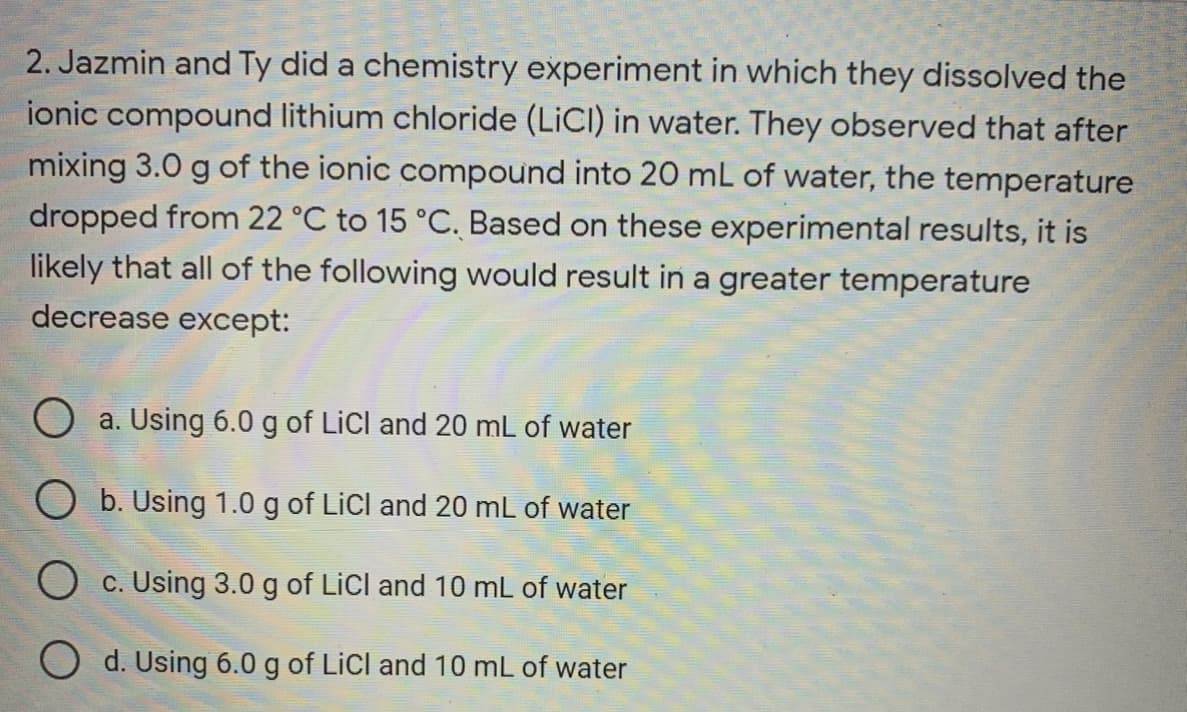2. Jazmin and Ty did a chemistry experiment in which they dissolved the ionic compound lithium chloride (LICI) in water. They observed that after mixing 3.0 g of the ionic compound into 20 mL of water, the temperature dropped from 22 °C to 15 °C. Based on these experimental results, it is likely that all of the following would result in a greater temperature decrease except: a. Using 6.0 g of LiCl and 20 mL of water
2. Jazmin and Ty did a chemistry experiment in which they dissolved the ionic compound lithium chloride (LICI) in water. They observed that after mixing 3.0 g of the ionic compound into 20 mL of water, the temperature dropped from 22 °C to 15 °C. Based on these experimental results, it is likely that all of the following would result in a greater temperature decrease except: a. Using 6.0 g of LiCl and 20 mL of water
Chemistry: An Atoms First Approach
2nd Edition
ISBN:9781305079243
Author:Steven S. Zumdahl, Susan A. Zumdahl
Publisher:Steven S. Zumdahl, Susan A. Zumdahl
Chapter7: Chemical Energy
Section: Chapter Questions
Problem 61E: A coffee-cup calorimeter initially contains 125 g water at 24.2C. Potassium bromide (10.5 g), also...
Related questions
Question
100%

Transcribed Image Text:2. Jazmin and Ty did a chemistry experiment in which they dissolved the
ionic compound lithium chloride (LICI) in water. They observed that after
mixing 3.0 g of the ionic compound into 20 mL of water, the temperature
dropped from 22 °C to 15 °C. Based on these experimental results, it is
likely that all of the following would result in a greater temperature
decrease except:
O a. Using 6.0 g of LiCl and 20 mL of water
O b. Using 1.0 g of LiCl and 20 mL of water
O c. Using 3.0 g of LiCl and 10 mL of water
O d. Using 6.0 g of LiCl and 10 mL of water
Expert Solution
This question has been solved!
Explore an expertly crafted, step-by-step solution for a thorough understanding of key concepts.
This is a popular solution!
Trending now
This is a popular solution!
Step by step
Solved in 2 steps

Knowledge Booster
Learn more about
Need a deep-dive on the concept behind this application? Look no further. Learn more about this topic, chemistry and related others by exploring similar questions and additional content below.Recommended textbooks for you

Chemistry: An Atoms First Approach
Chemistry
ISBN:
9781305079243
Author:
Steven S. Zumdahl, Susan A. Zumdahl
Publisher:
Cengage Learning

Chemistry by OpenStax (2015-05-04)
Chemistry
ISBN:
9781938168390
Author:
Klaus Theopold, Richard H Langley, Paul Flowers, William R. Robinson, Mark Blaser
Publisher:
OpenStax

Chemistry for Engineering Students
Chemistry
ISBN:
9781337398909
Author:
Lawrence S. Brown, Tom Holme
Publisher:
Cengage Learning

Chemistry: An Atoms First Approach
Chemistry
ISBN:
9781305079243
Author:
Steven S. Zumdahl, Susan A. Zumdahl
Publisher:
Cengage Learning

Chemistry by OpenStax (2015-05-04)
Chemistry
ISBN:
9781938168390
Author:
Klaus Theopold, Richard H Langley, Paul Flowers, William R. Robinson, Mark Blaser
Publisher:
OpenStax

Chemistry for Engineering Students
Chemistry
ISBN:
9781337398909
Author:
Lawrence S. Brown, Tom Holme
Publisher:
Cengage Learning

Chemistry: Principles and Reactions
Chemistry
ISBN:
9781305079373
Author:
William L. Masterton, Cecile N. Hurley
Publisher:
Cengage Learning

Introductory Chemistry: A Foundation
Chemistry
ISBN:
9781337399425
Author:
Steven S. Zumdahl, Donald J. DeCoste
Publisher:
Cengage Learning

General Chemistry - Standalone book (MindTap Cour…
Chemistry
ISBN:
9781305580343
Author:
Steven D. Gammon, Ebbing, Darrell Ebbing, Steven D., Darrell; Gammon, Darrell Ebbing; Steven D. Gammon, Darrell D.; Gammon, Ebbing; Steven D. Gammon; Darrell
Publisher:
Cengage Learning